1. Al-Araji A, Kidd DP. Neuro-Behçet's disease: epidemiology, clinical characteristics, and management. Lancet Neurol. 2009; 8:192–204. PMID:
19161910.

2. Tursen U, Gurler A, Boyvat A. Evaluation of clinical findings according to sex in 2313 Turkish patients with Behçet's disease. Int J Dermatol. 2003; 42:346–351. PMID:
12755969.
3. Siva A, Kantarci OH, Saip S, Altintas A, Hamuryudan V, Islak C, et al. Behçet's disease: diagnostic and prognostic aspects of neurological involvement. J Neurol. 2001; 248:95–103. PMID:
11284141.

4. Akman-Demir G, Serdaroglu P, Tasçi B. Clinical patterns of neurological involvement in Behçet's disease: evaluation of 200 patients. The Neuro-Behçet Study Group. Brain. 1999; 122:2171–2182. PMID:
10545401.
5. Farah S, Al-Shubaili A, Montaser A, Hussein JM, Malaviya AN, Mukhtar M, et al. Behçet's syndrome: a report of 41 patients with emphasis on neurological manifestations. J Neurol Neurosurg Psychiatry. 1998; 64:382–384. PMID:
9527155.
6. Ikeda K, Abe M, Iwasaki Y, Kinoshita M. Neuro-Behçet's disease in Japan. Neurology. 1996; 47:614–615. PMID:
8757065.
7. Joseph FG, Scolding NJ. Neuro-Behçet's disease in Caucasians: a study of 22 patients. Eur J Neurol. 2007; 14:174–180. PMID:
17250726.

8. Kalra S, Silman A, Akman-Demir G, Bohlega S, Borhani-Haghighi A, Constantinescu CS, et al. Diagnosis and management of neuro-Behçet's disease: international consensus recommendations. J Neurol. 2014; 261:1662–1676. PMID:
24366648.

9. Hirohata S, Kikuchi H, Sawada T, Nagafuchi H, Kuwana M, Takeno M, et al. Clinical characteristics of Neuro-Behcet's disease in Japan: a multicenter retrospective analysis. Mod Rheumatol. 2012; 22:405–413. PMID:
21935641.

10. Ideguchi H, Suda A, Takeno M, Kirino Y, Ihata A, Ueda A, et al. Neurological manifestations of Behçet's disease in Japan: a study of 54 patients. J Neurol. 2010; 257:1012–1020. PMID:
20127350.

11. Houman MH, Bellakhal S, Ben Salem T, Hamzaoui A, Braham A, Lamloum M, et al. Characteristics of neurological manifestations of Behçet's disease: a retrospective monocentric study in Tunisia. Clin Neurol Neurosurg. 2013; 115:2015–2018. PMID:
23830180.

12. Talarico R, D'Ascanio A, Figus M, Stagnaro C, Ferrari C, Elefante E, et al. Behçet's disease: features of neurological involvement in a dedicated centre in Italy. Clin Exp Rheumatol. 2012; 30:S69–S72. PMID:
23009765.
13. Yoon DL, Kim YJ, Koo BS, Kim YG, Lee CK, Yoo B. Neuro-Behçet's disease in South Korea: clinical characteristics and treatment response. Int J Rheum Dis. 2014; 17:453–458. PMID:
24506839.

14. Lee SH, Yoon PH, Park SJ, Kim DI. MRI findings in neuro-Behçet's disease. Clin Radiol. 2001; 56:485–494. PMID:
11428799.

15. Davatchi F, Shahram F, Chams-Davatchi C, Sadeghi Abdollahi B, Shams H, Nadji A, et al. Behcet's disease: is there a gender influence on clinical manifestations. Int J Rheum Dis. 2012; 15:306–314. PMID:
22709493.

16. Noel N, Bernard R, Wechsler B, Resche-Rigon M, Depaz R, Le Thi Huong Boutin D, et al. Long-term outcome of neuro-Behçet's disease. Arthritis Rheumatol. 2014; 66:1306–1314. PMID:
24782188.

17. Borhani Haghighi A, Pourmand R, Nikseresht AR. Neuro-Behçet disease: a review. Neurologist. 2005; 11:80–89. PMID:
15733330.
18. Hatemi I, Hatemi G, Celik AF, Melikoglu M, Arzuhal N, Mat C, et al. Frequency of pathergy phenomenon and other features of Behçet's syndrome among patients with inflammatory bowel disease. Clin Exp Rheumatol. 2008; 26:S91–S95. PMID:
19026122.
19. Al-Araji A, Sharquie K, Al-Rawi Z. Prevalence and patterns of neurological involvement in Behcet's disease: a prospective study from Iraq. J Neurol Neurosurg Psychiatry. 2003; 74:608–613. PMID:
12700303.

20. Ashjazadeh N, Borhani Haghighi A, Samangooie S, Moosavi H. Neuro-Behcet's disease: a masquerader of multiple sclerosis. A prospective study of neurologic manifestations of Behcet's disease in 96 Iranian patients. Exp Mol Pathol. 2003; 74:17–22. PMID:
12645628.
21. Serdaroğlu P, Yazici H, Ozdemir C, Yurdakul S, Bahar S, Aktin E. Neurologic involvement in Behçet's syndrome. A prospective study. Arch Neurol. 1989; 46:265–269. PMID:
2919979.
22. Borhani-Haghighi A, Samangooie S, Ashjazadeh N, Nikseresht A, Shariat A, Yousefipour G, et al. Neurological manifestations of Behçet's disease. Saudi Med J. 2006; 27:1542–1546. PMID:
17013480.
23. Moghaddassi M, Togha M, Shahram F, Hanif H, Dadkhah S, Jahromi SR, et al. Headache in Behcet's disease: types and characteristics. Springerplus. 2016; 5:1077. PMID:
27462525.

24. Fountain EM, Dhurandhar A. Neuro-Behçet's disease: an unusual cause of headache. J Gen Intern Med. 2014; 29:956–960. PMID:
24549519.

25. Kidd D. The prevalence of headache in Behçet's syndrome. Rheumatology (Oxford). 2006; 45:621–623. PMID:
16368730.

26. Saip S, Siva A, Altintas A, Kiyat A, Seyahi E, Hamuryudan V, et al. Headache in Behçet's syndrome. Headache. 2005; 45:911–919. PMID:
15985109.

27. Borhani Haghighi A, Aflaki E, Ketabchi L. The prevalence and characteristics of different types of headache in patients with Behçet's disease, a case-control study. Headache. 2008; 48:424–429. PMID:
18205799.
28. Gökçay F, Celebisoy N, Gökçay A, Aksu K, Keser G. Neurological symptoms and signs in Behçet disease: a Western Turkey experience. Neurologist. 2011; 17:147–150. PMID:
21532383.
29. Lee HS, Kim DY, Shin HY, Choi YC, Kim SM. Spinal cord involvement in Behçet's disease. Mult Scler. 2016; 22:960–963. PMID:
26480923.

30. Kidd D, Steuer A, Denman AM, Rudge P. Neurological complications in Behçet's syndrome. Brain. 1999; 122:2183–2194. PMID:
10545402.

31. Lo Monaco A, La Corte R, Caniatti L, Borrelli M, Trotta F. Neurological involvement in North Italian patients with Behçet disease. Rheumatol Int. 2006; 26:1113–1119. PMID:
16794844.

32. Akman-Demir G, Tüzün E, Içöz S, Yeşilot N, Yentür SP, Kürtüncü M, et al. Interleukin-6 in neuro-Behçet's disease: association with disease subsets and long-term outcome. Cytokine. 2008; 44:373–376. PMID:
19010690.

33. Coban O, Bahar S, Akman-Demir G, Taşci B, Yurdakul S, Yazici H, et al. Masked assessment of MRI findings: is it possible to differentiate neuro-Behçet's disease from other central nervous system diseases? [corrected]. Neuroradiology. 1999; 41:255–260. PMID:
10344509.
34. Sumita Y, Murakawa Y, Sugiura T, Wada Y, Nagai A, Yamaguchi S. Elevated BAFF levels in the cerebrospinal fluid of patients with neuro-Behçet's disease: BAFF is correlated with progressive dementia and psychosis. Scand J Immunol. 2012; 75:633–640. PMID:
22340436.

35. Aykutlu E, Baykan B, Serdaroglu P, Gökyigit A, Akman-Demir G. Epileptic seizures in Behçet disease. Epilepsia. 2002; 43:832–835. PMID:
12181001.

36. Farahangiz S, Sarhadi S, Safari A, Borhani-Haghighi A. Magnetic resonance imaging findings and outcome of neuro-Behçet's disease: the predictive factors. Int J Rheum Dis. 2012; 15:e142–e149. PMID:
23253242.

37. Borhani Haghighi A, Sarhadi S, Farahangiz S. MRI findings of neuro-Behcet's disease. Clin Rheumatol. 2011; 30:765–770. PMID:
21165752.

38. Kotake S, Higashi K, Yoshikawa K, Sasamoto Y, Okamoto T, Matsuda H. Central nervous system symptoms in patients with Behçet disease receiving cyclosporine therapy. Ophthalmology. 1999; 106:586–589. PMID:
10080218.

39. Kikuchi H, Aramaki K, Hirohata S. Effect of infliximab in progressive neuro-Behçet's syndrome. J Neurol Sci. 2008; 272:99–105. PMID:
18550081.

40. Hirohata S, Kikuchi H, Sawada T, Nagafuchi H, Kuwana M, Takeno M, et al. Retrospective analysis of long-term outcome of chronic progressive neurological manifestations in Behcet's disease. J Neurol Sci. 2015; 349:143–148. PMID:
25601769.

41. Santos Lacomba M, Marcos Martín C, Gallardo Galera JM, Gómez Vidal MA, Collantes Estévez E, Ramírez Chamond R, et al. Aqueous humor and serum tumor necrosis factor-alpha in clinical uveitis. Ophthalmic Res. 2001; 33:251–255. PMID:
11586057.
42. Aldinucci A, Bonechi E, Biagioli T, Repice AM, D'Elios MM, Emmi L, et al. CSF/serum matrix metallopeptidase-9 ratio discriminates neuro Behçet from multiple sclerosis. Ann Clin Transl Neurol. 2018; 5:493–498. PMID:
29687026.

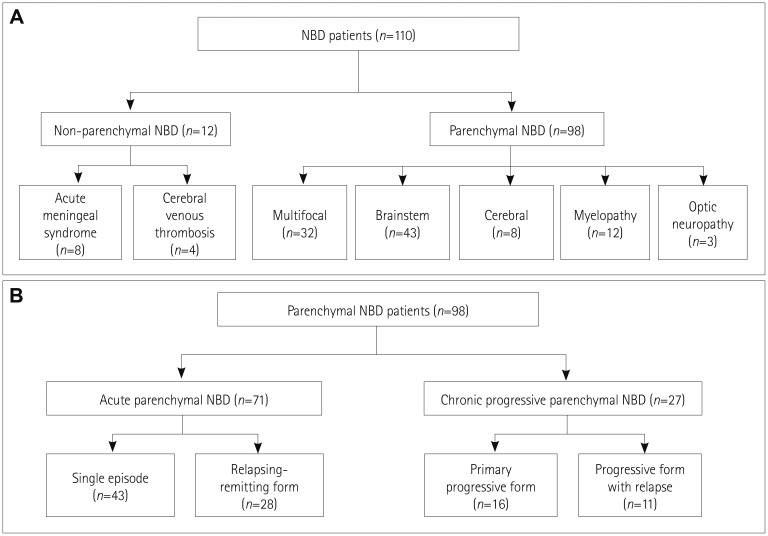
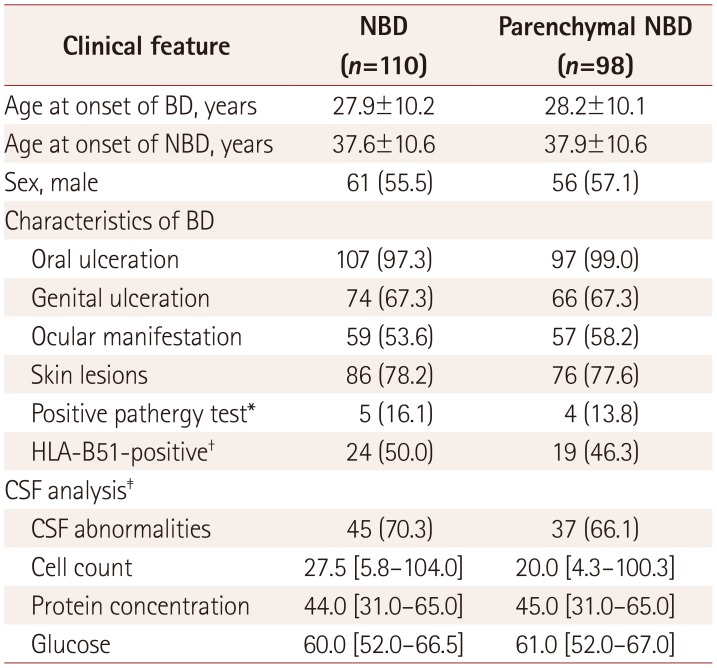




 PDF
PDF ePub
ePub Citation
Citation Print
Print



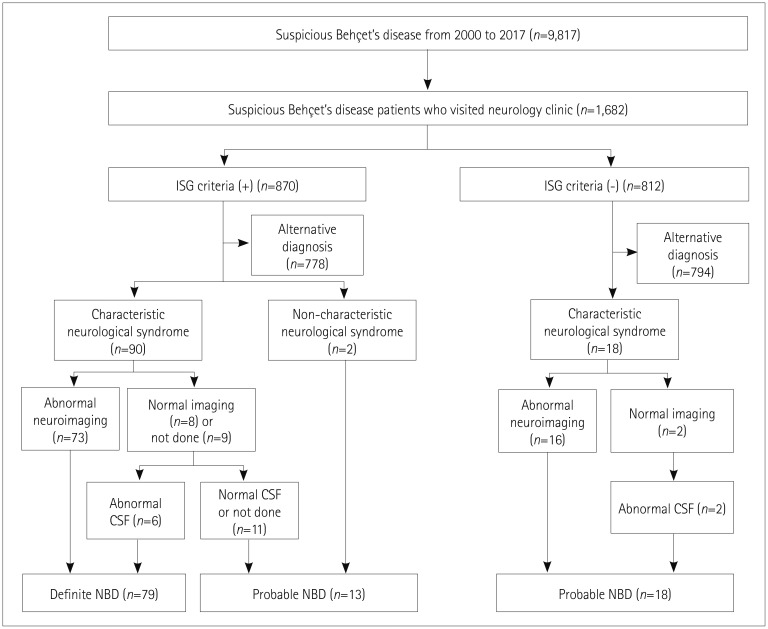
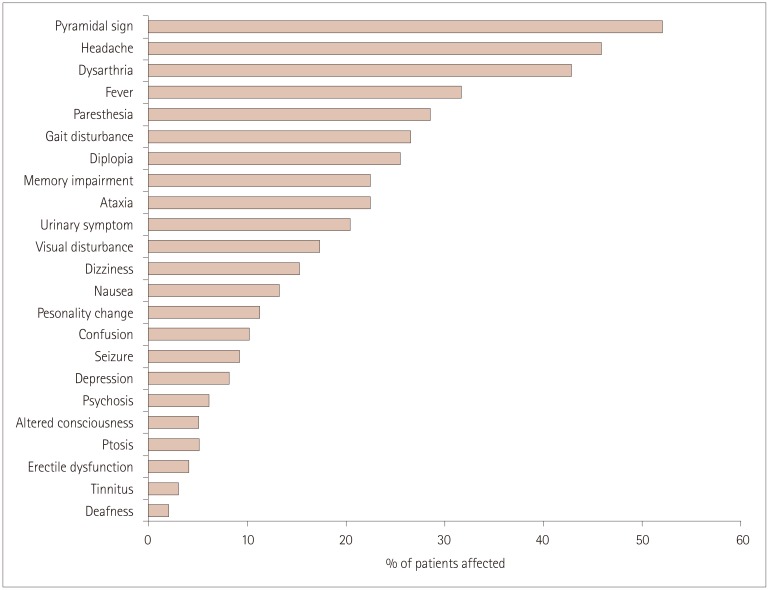
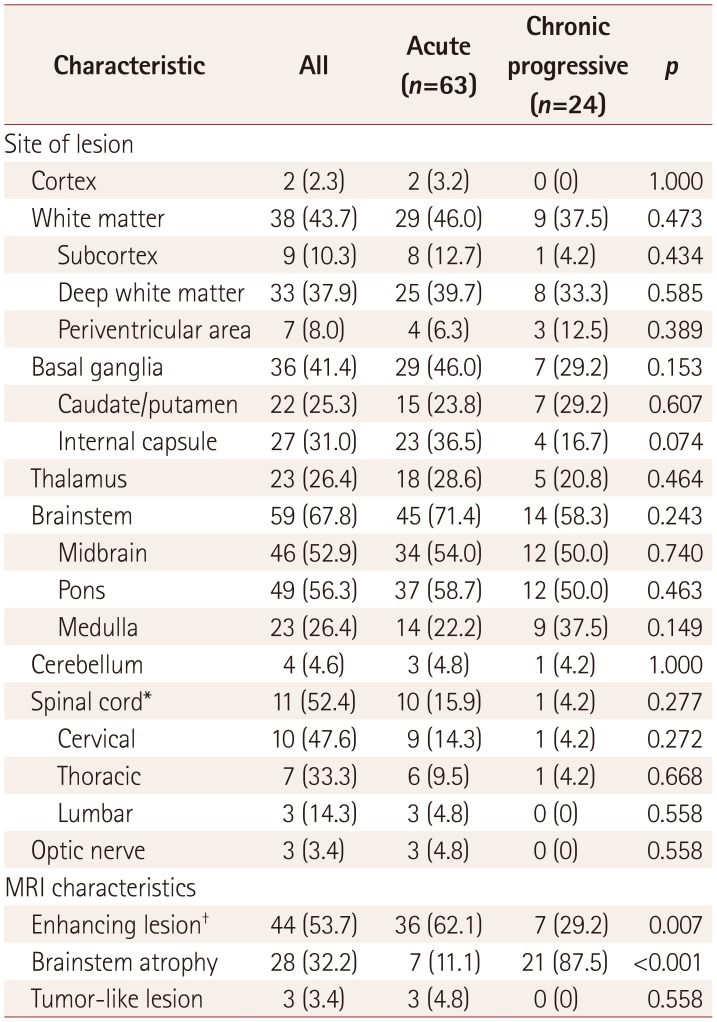
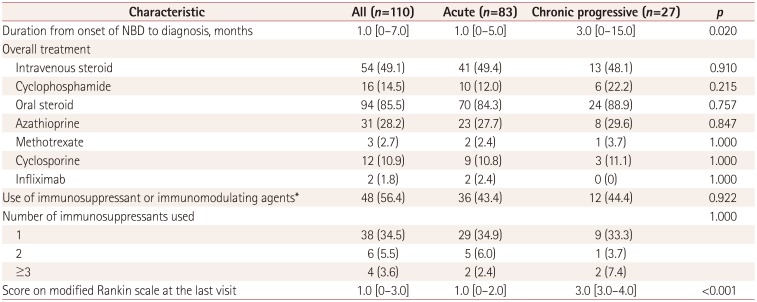
 XML Download
XML Download